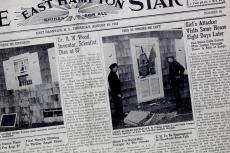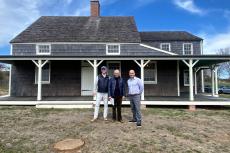At what point does the sheer weight of public opinion against a project matter?
A good test might be the public hearing held on Feb. 8 regarding the draft environmental impact statement and the subdivision plan for the proposed Wainscott Commercial Center, which would create 50 commercial lots on a 70-acre parcel just north of Montauk Highway.
The room at LTV studios looked to accommodate about 100 people, and by 3 p.m., when the first part of a two-part hearing began, it was about half full. Four and a half hours later, minus an hourlong dinner break, 47 people had walked up to the microphone or phoned in to offer their comments, almost all of them strongly condemning the project at the former sand mine.
Some, like Frank Pearson, a former New York State Department of Transportation engineer for Long Island, used their expertise in a specific area. He criticized many aspects of the traffic study in the D.E.I.S., noting that “traffic counts were collected in August 2017, over five years ago. Traffic patterns have changed since the pandemic.”
He also said the State D.O.T. was “unlikely” to approve some of the traffic mitigations proposed by the applicant, and that the traffic analysis submitted as part of the environmental impact statement did not sufficiently account for side-road traffic or the effects of that traffic on pedestrians and bicyclists.
Christopher Gobler, a professor at Stony Brook University’s School of Marine and Atmospheric Sciences, has studied water quality at Georgica Pond, a few hundred feet southeast of the former sand mine, for over a decade.
Through his studies, he determined that the nitrogen load in the pond had to be reduced by 60 percent to improve the health of the pond. Progress has been made through the years as “dozens” of residents in the area have upgraded their septic systems to low-nitrogen systems.
“Despite all that, the project proposed is going to significantly increase nitrogen load by hundreds of pounds per year,” Dr. Gobler said. “The D.E.I.S. gets it completely wrong when it comes to nitrogen loading. They’re using incorrect assumptions, and state in their D.E.I.S. there will be no nitrogen loading in Georgica Pond. They’re clearly ignoring all the science that’s been done during the past decade,” he said.
The travel time for groundwater to move from the proposed commercial center to Georgica Pond is less than two years, “for the entire property.”
“We can expect increased nitrogen loading, more toxic algal blooms, increased fish kills, and increased threat to human health,” should the project move forward, he concluded.
Another water quality expert, Peter Topping, the executive director of Peconic Baykeeper, put it succinctly when he said, “You cannot reduce a nutrient or pollution load by adding a pollution load.”
Reed Super, an environmental lawyer speaking on behalf of the Friends of the Georgica Pond Foundation, ticked off many points of contention with the document.
The magnitude of the project is out of whack with the area, he said. At three times the size of the existing Wainscott business district, Mr. Super said it would strain the area’s infrastructure. The placement of a commercial subdivision at the gateway to East Hampton Town, and so close to Georgica Pond, is problematic, he asserted.
“The applicant’s D.E.I.S. needs substantial revision or supplementation, before the board can complete the” final environmental impact statement, he said, arguing that many sections “do not comply with the final scope,” and those that loosely follow the scope still fail to provide an adequate level of analysis.
“Of the 11 categories of adverse environmental impacts that this board determined are potentially significant, the applicant’s D.E.I.S. recommends that the board now find that all of them are insignificant. Such conclusions are not supported by the underlying facts and analysis and are frankly absurd.”
Mr. Super said there was no overriding public need for the project and that it was incompatible with both the town’s comprehensive plan of 2005 and the Wainscott Hamlet Study of 2019.
Other residents did not have titles or specific expertise, but highlighted concerns they felt were not included in the D.E.I.S.
Lynn Cronin, a 40-year resident of Wainscott, said she understood the way people around the hamlet move. “Residents need to go to the post office to retrieve their mail; it’s not delivered. We walk with children, push strollers.” Not only is the quantity of the traffic a real concern, she said, but the quality. Increasing commercial traffic would “increase the odds of a dangerous occurrence” on local roads.
Ms. Cronin also noted that the town Police Department is just north and west of the property. “You are kidding yourself if you think the traffic will not impede the police from getting where they need to be in a timely manner,” she said. “The safety of all residents would be at risk.”
It wasn’t only Wainscott residents who expressed concern.
A resident of Noyac, Patricia Currie, said, “East Hampton in not an island,” and said Noyac Road is now a major bypass for commercial vehicles to get to points east. “Frankly, I’m gobsmacked that the D.E.I.S. has not included any reference to diversions of traffic that will occur in neighboring communities.”
Meanwhile, Robert Pine, who lives in Springs, which also has a hamlet plan, worried what sort of precedent would be set if the former sand mine in Wainscott were developed in a manner strongly counter to the Wainscott Hamlet Study. “I worry what happens when a similar sandpit in the Springs comes up for a review.”
(There is an active sand mine on Springs-Fireplace Road in East Hampton, on the way to Springs.)
“What is the point of having a hamlet plan if you just ignore it?” he asked.
Hersey Egginton was one of several Hedges Lane residents who spoke up. Hedges Lane is the eastern border of the sand mine property. Mr. Egginton said his first daughter was diagnosed with non-Hodgkin’s lymphoma, and that in the last five years Wainscott’s groundwater had been declared unsafe to drink. Well water in the hamlet was found to contain high levels of the toxic chemicals perfluorooctanoic acid (PFOA) and perfluorooctane sulfonic acid (PFOS).
“We concluded that our daughter’s cancer likely stemmed from the Hedges Lane well water she ingested as an infant, and as a child,” he said.
He argued the water quality studies in the D.E.I.S. insufficiently tested the groundwater. The applicants had only drilled three test holes.
“Arguably all 50 lots should be tested, and the results made public,” he said.
Jeremy Samuelson, the East Hampton Town planning director, said written submissions to the planning board would be accepted through March 13.
State law allows the applicant 45 days to produce a final environmental impact statement.
In that time frame, “the Planning Department, in concert with the applicant, will assemble the full volume of comments submitted in person and in writing,” said Mr. Samuelson. “We’ll go comment by comment and evaluate which meet the standards that can be considered part of the review.” It is not unusual for extensions to be granted.
In the meantime, the town zoning board of appeals has 62 days from its Feb. 7 meeting to render a decision on whether the Wainscott Commercial Center needs a special permit for a planned industrial park.
Both timelines end in April.




